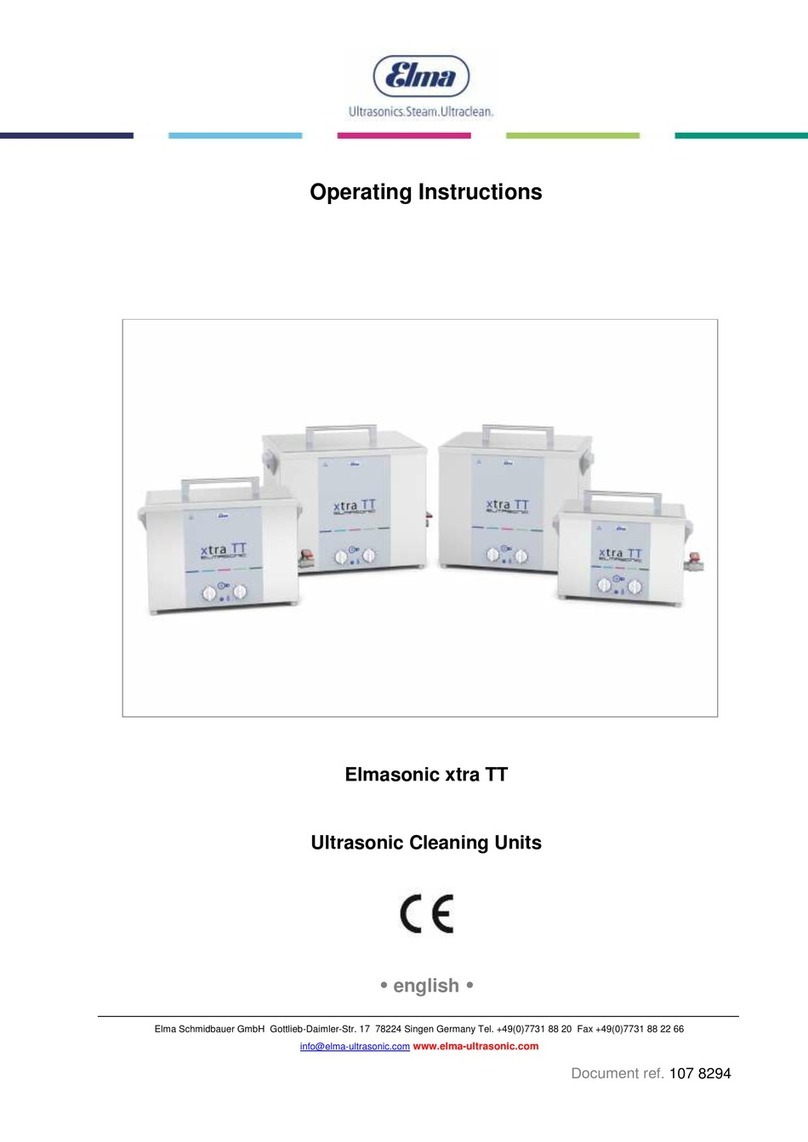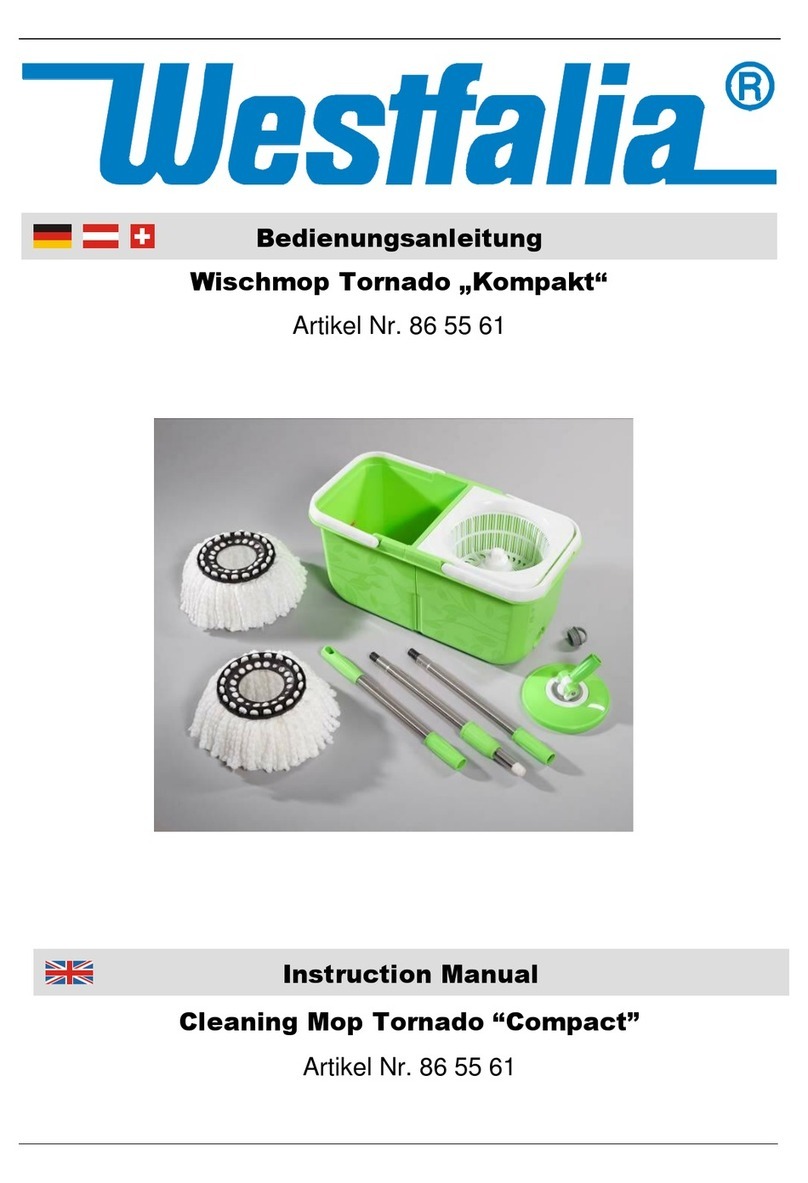Esteam CLEANCO TRUCKMOUNT SLX 47 Operation manual

SLX 47
Operations and Service Manual
VERSION AUG 2020
Made in Canada

1
TABLE OF CONTENTS
Table of Contents 1
Machine Data Log 2
Safety Instructions 3
Technical Specifications 5
Receiving Your Truckmount 6
Installation Requirements 7
Battery Connection 8
Fuel Requirements 8
Engine Requirements 8
General information 9
- Local Water Conditions
- Waste Water Disposal
- Cleaning Solutions & Cleaning
- Cleaning Wand Porcedure
Operating Instructions 10
- Start Up
- Shut Down
Deflooding Operations 11
Freeze Guard Procedure 11
Water Flow System 12
High Pressure Pump 12
Vacuum System 12
Electrical System 13
Heat Exchangers 13
Hays Rear Bearing Support 13
Upper Front Panel 13
Lower Front Panel 14
Recovery Tank 14
Maintenance 15
- Daily
- Weekly
- Monthly
- Quarterly
Service Interval Chart 16
Trouble shooting 17-20
Upper Front Control Panel 21
Lower Front Panel 21
Helpful Tips 22-25
Water Flow Diagram 26
Parts Upper Front Panel 27
Parts Lower Front Panel 27
Parts Liquid Heat Exchanger 27
Parts Exhaust Heat Exchanger 28
Parts Blower Assy 28
Parts High Pressure Pump Assy 28

2
MACHINE DATA LOG/OVERVIEW
MODEL
DATE OF PURCHASE
SERIAL NUMBER
COMPANY NAME
YOUR DEALER
NAME:
ADDRESS:
PHONE NUMBER:
Welcome…and congratulations on the purchase of your Cleanco Truckmount. This instruction
manual is a guide for operating and servicing your unit. Read this manual completely before
installing or operating this unit. This unit offers you personal convenience. All of your
instrumentation and controls have been positioned to give you easy access for operation and
daily maintenance.
Proper operation and service are essential to the efficient functioning of this unit. When
maintained correctly, this unit will have a long, trouble-free life.
The service methods described in this manual are explained in such a manner that servicing
may be performed accurately and safely. Proper service varies with the choice of procedure,
the skill of the mechanic, and the tools or parts available. Before attempting any repair, make
certain that you are thoroughly familiar with this equipment and are equipped with the proper
tools. Any questions pertaining to operating or servicing this unit should be directed to your
nearest dealer.
THIS UNIT MUST BE INSTALLED BY THE DEALER FROM WHOM YOU PURCHASED IT
IN ACCORDANCE WITH THE PRESCRIBED INSTALLATION PROCEDURES.
MAKE CERTAIN THAT THE WARRANTY FORM IS FILLED OUT AT THE TIME OF
INSTALLATION AND IS RETURNED TO;
ESTEAM MANUFACTURING LTD
3750 19TH ST. N.E
CALGARY, ALBERTA, CANADA T2E 6V2
Information in this document is subject to change without notice and does not represent a commitment
on the part of Esteam Manufacturing Ltd.
IMPORTANT SAFETY INSTRUCTIONS

3
When using this machine, basic precautions must always be followed, including the following:
READ ALL INSTRUCTIONS BEFORE USING THIS MACHINE
These symbols mean WARNING or CAUTION. Failure to follow warnings and cautions
could result in fatality, personal injury to yourself and/or others, or property damage.
Follow these instructions carefully!
Read the operator’s manual before installing or starting this unit. Failure to adhere to instructions
could result in severe personal injury or could be fatal.
Operate this unit and equipment only in a well-ventilated area. Exhaust fumes contain carbon
monoxide, which is an odorless and deadly poison that can cause severe injury or fatality. DO NOT run
this unit in an enclosed area. DO NOT operates this unit where the exhaust may enter any building
doorway, window, vent, or opening of any type.
This unit must be operated with the vehicle doors open in order to ensure adequate ventilation to the
engine.
DO NOT store any type of flammable material in the vehicle.
DO NOT operate engine if gasoline is spilled. Avoid creating any ignition until the gasoline has been
cleaned up. Never use gasoline as a cleaning agent.
DO NOT place hands, feet, hair, or clothing near rotating or moving parts. Avoid any contact with
moving parts! Rotating machinery can cause injury or fatality.
Never operate this unit without belt guards or hoods. The high-speed moving parts, such as belts
and pulleys, should be avoided while this unit is running. Severe injury, damage or fatality may result.
DO NOT service this unit while it is running. The high-speed mechanical parts as well as high
temperature components may result in severe injury or severed limbs.
Never touch electrical wires or components while the engine is running. They can be sources of
electrical shock.
Before servicing this unit, allow it to “cool down.” This will prevent burns from occurring.
Water under high pressure at high temperature can cause burns, severe personal injury or fatality.
Shut down machine, allow to cool down, and relieve system of all pressure before removing
valves, caps, plugs, fittings, filters, and bolts.
NEVER leave the vehicle engine running while the unit is in operation.
Always wear hearing protection when unit is running. Always comply with local noise ordinance
when operating units.

4
Dangerous Acid, Explosive Gases! Batteries contain sulfuric acid. To prevent acid burns, avoid
contact with skin, eyes and clothing. Batteries produce explosive hydrogen gas while being charged. To
prevent a fire or explosion, charge batteries only in well-ventilated areas. Keep sparks, open flames, and
other sources of ignition away from the battery at all times. Keep batteries out of the reach of children.
Remove all jewelry when servicing batteries.
Before disconnecting the negative (-) ground cable, make sure all switches are OFF. If ON, a spark will
occur at the ground cable terminal which could cause an explosion if hydrogen gas or gasoline vapors are
present. When disconnecting the battery, ALWAYS disconnect the negative (-) terminal FIRST.
DO NOT smoke around the unit. Gas fumes may accumulate and be ignited. The battery is also
extremely flammable. This will prevent possible explosions.
DO NOT damage the vehicle in any manner during installation. When routing fuel lines DO NOT
place the hose in any location where damage may occur to the hose or vehicle. Avoid any contact with
moving parts, areas of high temperature, brake lines, fuel lines, muffler, catalytic converter, or sharp
objects.
DO NOT exceed your vehicle’s payload capacity. Check with the vehicle manufacturer for the gross
Vehicle weight Rating (GVWR) GVWR is the maximum allowable combined weight of the vehicle,
including all passengers, fuels, tools, and cargo.
DO NOT operate this unit without the water supply attachment turned on. The water pump and
other vital components may be seriously damaged if this unit is permitted to operate dry without water.
DO NOT operate this unit without the filter installed in the waste tank.
Keep your vehicle work area clean. Wands, stair tools, and other accessories must be securely
fastened before driving the vehicle.
All high-pressure hoses must be rated for 3000 PSI at 2500F. Thermoplastic hoses do not meet
these specifications and should not be used. Severe burns and injury may result if the hoses do not meet
these requirements.
Make certain that you receive complete training by the distributor from whom you purchased this
unit.
This unit uses high pressure and temperature. Improper or irresponsible use may result in
serious injury.
Do not modify this unit in any manner. Improper modification can cause severe personal injury or
fatality, and will void your warranty

5
TECHNICAL SPECIFICATIONS
ITEM
DIMENSION/CAPACITY
Engine speed
2850 rpm (high speed) Water Pump ON/No
Load
Water pump rpm
1625 rpm
Vacuum pump rpm
2850 rpm
Water flow rate
4 GPM (maximum)
Water pump pressure
2000 PSI (maximum)
Vacuum relief valve
13” Hg
Waste tank capacity
90 gallons
Console weight (with waste tank)
1650 lbs.
Pump Belt size
AX28
Blower Belt size
BX37
JET SIZING:
Recommended floor tool tip sizing should not exceed a total of “.045”. Using larger jet sizes on your
cleaning unit may reduce cleaning temperatures.
Example: Dual-jet wand uses two 11001.5 jets (110 deg spray angle w/ 01.5 orifice).
015 x 2 = 03
Three-jet wand uses three 11001 jets (110 deg spray w/1.0 orifice).
Quad-jet wand uses four 9501 jets (95 deg spray angle w/ 1.0 orifice)
01 x 4 = 04
Upholstery tool jet size: 80015
Stair tool jet size: 9502 or two 9501.5

6
RECEIVING YOUR TRUCKMOUNTED UNIT
DEALER RESPONSIBILITIES
The Esteam / Cleanco authorized dealer that you purchased this unit from
is responsible for:
1. Correctly installing and properly securing equipment with proper hardware and underside
mounting plates.
2. Checking the components and oil levels prior to starting the unit.
3. Check that all components are operating at the factory specifications.
4. Checking all hoses and accessories for correct operation.
5. Checking all tools / wands for correct operation.
6. Training you in the operation, maintenance and safety precautions of your unit.
It is the purchaser’s responsibility to become familiar with the entire Owner’s Manual, most of all
Warnings, Cautions, and Notices.
ACCEPTANCE OF SHIPMENT
Your SLX 47 truckmount was thoroughly tested, checked and inspected in its entirety prior to leaving our
manufacturing facility. When receiving your unit, please make the following acceptance check:
1. The unit should not show any signs of damage. If there is damage, notify the deliverer
immediately.
2. Carefully check your equipment. The SLX 47 should arrive with the following items as well as any
optional accessories you may have ordered:
EQUIPMENT LIST
Cleanco SLX Console
Recovery tank with auto shut-off
Recovery tank vacuum hoses
Installation mounting plates and hardware
Hose clamps for vacuum, water and fuel hoses
150 ft. of high pressure solution hose
150 ft of 2” vacuum hoses
10ft x 1.5” Lead vacuum hose
TM Carpet Wand
Chemical Jug
Battery Box

7
INSTALLATION REQUIRMENTS
Prior to starting installation, read the ENTIRE Installation section of this manual. Since the SLX 47
truckmount weighs over 1000 lbs., adhere to the following recommendations prior to installing the unit.
The unit should not be installed in any vehicle rated less than ¾-ton capacity.
DO NOT exceed the vehicles payload capacity, check with vehicle manufacturer for Gross Vehicle Weight
Rating (GVWR).
If mounting the unit in a trailer, ensure that the trailer is rated for the total weight of the unit and trailer.
Electric or hydraulic brakes must be provided, and strict compliance with all State/ Provincial and Federal
laws must be maintained.
If mounting in a trailer, the SLX 47 console must be positioned so that it balances properly with respect to
the trailer axle. Ten percent (10%) of the unit’s overall weight (w/o accessories or water) should be on the
tongue. This unit has an air-cooled engine, and adequate ventilation must be provided to prevent
overheating.
Cleanco does not recommend using any type of flooring materials that absorb water. This will result in
rust and corrosion of the vehicle floor. Insulation under rubber mats should be removed prior to
installation of the unit.
WARNING
This unit must be bolted to the floor of the vehicle by an authorized CLEANCO DISTRIBUTOR
LIFTING THE UNIT INTO THE VEHICLE
Because the SXL 47 console weighs over 1000 lbs., a forklift is necessary to place the unit into the
vehicle. Place the forks under the unit, using two “C” clamps; secure the console to the forks.
POSITIONING THE UNIT INTO THE VEHICLE
Vehicle vary in size and openings. All owners have different preferences on where in the vehicle they
want their units positioned. Cleanco highly recommends a side door installation for the SLX 47. We do not
recommend a rear door installation.
FASTENING DOWN THE UNIT AND WASTE TANK
Prior to drilling any holes in the vehicle floor, check underneath the vehicle to ensure that while drilling
you will not damage the fuel tank, fuel lines, or any other vital components which could affect the vehicle
safety and operation.
The console and waste tank have pre-drilled mounting holes. Drill 10 holes for mounting of console and 4
holes for mounting waste tank. The console and waste tank can be used as a template for drilling holes.
Using the provided mounting hardware kit:
Insert the 3/8” x 3” GR2 hex head bolts with flat washers through the console and waste tank mounting
holes. Place the mounting plates onto the bolts and secure with the 3/8” flanged nut. Tighten until the
console and waste tank are firmly attached to the vehicle floor.

8
BATTERY CONNECTION
Batteries contain sulfuric acid; avoid contact with skin, eyes, and clothing. Batteries also produce
explosive hydrogen gases while charging. To prevent explosion or fire, charge batteries in a well-
ventilated area only. Keep sparks, open flames, and any other sources of ignition away from batteries at
all times. Remove all jewelry prior to servicing batteries. Keep out of reach of children.
Attach the red positive (+) battery cable from the starter solenoid on the console to the positive (+)
terminal on the battery and tighten down the nut.
Attach the black negative (-) battery cable from the ground on the console to the negative (-) terminal on
the battery and tighten down the nut.
Before disconnecting the negative (-) ground cable, ensure that all switches are in the OFF position. If ON
a spark could occur at the ground connection terminal, which could cause an explosion if hydrogen gas or
gasoline vapors are present. ALWAYS disconnect the negative (-) terminal first.
FUEL REQUIREMENTS
Use unleaded fuel ONLY. Use only fresh, clean unleaded gasoline with a minimum octane rating of 87.
Do Not use high-octane gasoline. Gasoline with up to, not exceeding 10% ethanol is acceptable.
NOTE: using other gasoline / alcohol blends including E20 and E85 will cause damage to engine
components and will void warranty.
ENGINE REQUIREMENTS
Use high quality oil of at least API (American Petroleum Institute) service class SG or higher. Do not use
additives. High quality 30W oil is recommended. It is never recommended to extend oil change intervals
past 200 hours.
Engine Oil Capacity 3.4L
3.59US qts

9
GENERAL INFORMATION
The Cleanco SLX 47 Truckmount has been designed for
the professional cleaner who demands a high
performance-cleaning unit. Dependable performance is
the guiding principal in the design and construction of
the Cleanco SLX 47. Although the Cleanco SLX 47 is
designed with simplicity in mind, this truckmounted
carpet cleaning plant has many functions that perform
simultaneously.
Engine has to run at a continuous RPM.
High Pressure water pump provides steady pressure
at the proper flow for cleaning.
Vacuum Blower has to pull air and soiled water back
from the site.
Cleaning solution has to be injected into the water
flow at the right concentration.
Heating system must deliver and maintain proper
heat.
The vacuum recovery tank stores soiled water for
proper disposal.
This manual contains operation instructions as well as
information required for proper maintenance,
adjustments, and repair of this unit. To assist with proper
diagnosis of a problem, a general troubleshooting has
been included for your convenience.
LOCAL WATER CONDITIONS
The quality of water varies greatly throughout North
America. This can influence the reliability and efficiency
of your equipment. Many areas have an excess of
minerals in the water, which results in what is known as
hard water. These minerals tend to adhere to the inside
of heat exchangers and other parts of the machines
causing damage and loss of cleaning effectiveness.
Cleaning effectiveness and equipment life is increased
when water softeners are used in hard water areas. The
low cost of water softeners is more than made up for by
the increased life of machine parts and cleaning
efficiency.
WASTE WATER DISPOSAL
There are laws throughout North America that prohibit
the dumping of soiled water from carpet cleaning
equipment in any place but a sanitary treatment system.
The water recovered into your unit’s recovery tank
contains materials such as detergent residue and many
different soil contaminants removed from the carpet you
have cleaned. These materials must be processed
before they are safe to re-enter our streams, rivers and
reservoirs.
AS PER FEDERAL, STATE AND LOCAL LAWS, DO
NOT DISPOSE OF WASTE WATER INTO STORM
DRAINS, GUTTERS, STREAMS, RESERVOIRS, ETC.
CLEANING SOLUTIONS & CLEANING
Your Cleanco SLX 47 has been designed with the latest
technology to produce the highest quality cleaning
results possible. However, it is only one of many tools of
the carpet cleaning trade, and can produce only as good
as the person operating it. There are no short cuts to
quality. It takes time, cleaning knowledge, and the
proper use of quality cleaning solutions.
Cleanco recommends Esteam Cleaning Systems brand
name for use in your Cleanco SLX 47. Also, be sure to
follow directions of all cleaning solutions, to obtain
quality results and for safety. The improper use of
cleaning solutions in your Cleanco SLX 47 can cause
serious damage to the plumbing system, high-pressure
pump, and heat exchangers. (Cleanco does not
recommend running products through your unit such as
solvents, or grease removers with a high concentration
of solvents).
CLEANING WAND PROCEDURE
To have a quality cleaning result, correct wand
movement is of the utmost importance. Failure to take
time and extra care can result in an unhappy client.
Always move the cleaning wand in a smooth forward
and backward motion. Apply slight pressure on the
forward stroke while injecting cleaning solution onto the
carpet. Then on the backstroke towards yourself again
apply slight pressure on the wand and inject and vacuum
cleaning solution. Continue this method over-lapping
each forward and backstroke, for about a three to four
foot square area. Once the three square foot area has
been completed, return back over the same area-
utilizing vacuum only. Moving across then clean and
vacuum the next three to four square feet and again
repeating the extra vacuum pass. A good rule to
remember is for every one wet pass, two dry (vacuum)
passes are required. Failure to adopt good wanding
procedures can result in streaking, over wetting,
browning and longer drying times.
Over wetting not only leaves a bad impression with your
client but may also require an extra trip back to correct
annoying problems such as browning. There are several
things that could cause over wetting:

10
1. Not enough vacuum strokes, or incorrect wanding
procedures.
2. Clogged vacuum blower filter.
3. Clogged lint basket filter.
4. Vacuum tank not sealed properly.
5. Obstruction in the vacuum hose, or kink in the
vacuum hose.
6. Vacuum tank drain valve partially open.
7. Cleaning a heavily foam-saturated carpet without
defoamer.
OPERATING INSTRUCTIONS
NOTE: Before operating the unit, make sure you are in a
well-ventilated area. Exhaust fumes from the vehicle
contain carbon monoxide and are hazardous to your
health and your client’s health. Do not operate the unit
or the vehicle near any building doorways, windows,
or openings of any kind.
1. Check your fuel gauge to ensure you have enough
fuel for the job.
2. Check to make sure you have an adequate amount
of fresh water in your fresh water tank to complete
the entire job. If not, fill fresh water tank prior to
starting the job.
3. Check your chemical jug to ensure that you have
enough concentrated solution for the required job. If
not, mix and fill the chemical jug with the desired
cleaning solution.
4. Lay out all hoses required. When connecting hoses
start from the furthest point to be cleaned and work
back towards the unit. This will ensure that you
have the proper length required. Once at the
Cleanco SLX47 unit, connect the high-pressure
hose to the Red for carpet cleaning or Yellow quick
disconnect for upholstery cleaning on the front
panel.
5. Do not connect vacuum hose to vacuum port at this
point; this will occur after unit is started.
START UP
1. Make sure the van is in the park position and the
emergency brake is set, and turn off vehicle engine.
2. Pull the engine choke out, turn the key switch to the
start position and hold until the engine starts.
Immediately push the choke cable in and let the
engine idle until warmed up (do not start the unit
with the throttle out at full speed, always start the
unit and let it warm up at idle speed). Once warmed
up throttle the engine up to the desired speed.
3. Turn on the high-pressure pump switch to the “ON”
position and set the water pressure to the desired
pressure.
4. Check the thermostat for the desired cleaning water
temperature. Most cleaners run their unit from 180-
210 degrees depending on the type of surface being
cleaned. You do not need to run the unit at “full”
throttle to get the desired heat from the unit. For
example; to run at 200 degrees, you only need to
run the engine at 2400-2600 RPM.
5. With the cleaning tool attached, adjust the chemical
metering system by turning the chemical metering
knob counter clockwise until the float ball in the
chemical meter sits at 2 or 3 GPH. (you will need to
have water flow through the machine (tool keyed
“on” for it to meter chemical properly). Please note,
water pressure and volume will change the chemical
metering slightly. It is important to set the chemical
metering with the specific tool being used.
6. Standard carpet cleaning pressures should be
between 350 to 500 psi. Upholstery pressures
should be between a minimum of 200 psi and
throttle set at 2000 RPM.
7. Connect the vacuum hose to the unit and the male
end of the pressure hose to the carpet wand or tool
being used.
8. You are now ready to start cleaning.
NOTE: The machine will automatically shut down when
it reaches full capacity due to the high-level float switch
located inside the wastewater recovery tank. When this
occurs, empty the recovery tank at an approved disposal
site and flush. To save time on emptying recovery tanks
Cleanco recommends that you have THE Cleanco TM
External Pump Out (APO) installed on your recovery
tank. Please note –Foam can and will damage your
machine over time. A proper defoamer should be on
hand at all times.
SHUT DOWN
1. Throttle the engine down to a low idle.
2. Lay vacuum hoses out in order for all moisture to be
removed from hoses. This prevents spillage of any
soiled water in your vehicle when storing hoses.
3. Turn the water temperature thermostat to its lowest
setting and run the unit for 3 minutes, this will allow
cool water to run through the unit.
4. Turn the high-pressure pump switch to the “OFF”
position.
5. Disconnect all vacuum and high-pressure hose and
place them in the van. Also, place the carpet wand
and any tools that were on the job site into the van.
6. With the engine at low idle and no hoses connected
depress the blower lube valve button and hold for 4
seconds.
7. Turn the unit off.
8. Remove the lift out lint basket located in the
recovery tank, clean, and replace the lint basket
back into the recovery tank.
9. Always drain the recovery tank at an approved
disposal site.

11
DE-FLOODING OPERATIONS
De-flooding operations involve removal of water from
carpet and flooring. This differs from normal cleaning
operations in that no water or solution is required. A
Cleanco TM External Pump Out is recommended for all
de-flooding operations due to the large amount of water
removal often required.
1. Turn down Thermostat to 70 degrees to activate
solenoid.
2. Turn off Chemical Meter.
3. Start unit and set throttle at 2850 PRM
4. Turn pump switch on.
5. Set pump pressure at 300 PSI.
Remember, it is very important to make sure you have
an adequate water supply to the machine. Failure to
allow the machine to cool while performing water
extraction will cause excessive heat and damage to the
system and void your warranty.
FREEZE GUARD PROCEDURE
Note: The purpose behind this method
is to evacuate the system of water and
solution instead of filling all the water
carrying cavities with antifreeze. This
method will remove 95% or more thus
even if it freezes there will be no
damage.
1. Drain fresh water tank.
2. Remove chemical jug from unit and store in warm
place.
3. Remove quick connect from fresh water tank to the
Cat pump.
4. Connect the Freeze Guard Hose Assembly to
either one of the Red Panel quick connects and
the other end into the vacuum inlet on the wing
panel.
5. Start the unit on low idle and turn on the pump
clutch switch.
6. Open the Chemical Flow Meter about 2 –3 turns.
7. Turn the Thermostat knob to the off position.
8. Observe the fluid being drawn through the Freeze
Guard Hose, when this is completed and your
Chemical Flow Meter is empty, turn off Chemical
Flow Meter.
9. Disconnect the Freeze Guard Hose and insert into
the next Red quick connect and follow the same
procedure until no visible fluid is achieved. Repeat
the process for the Yellow and Blue quick
connects.
10. With the unit evacuated, now is the time to
evacuate the solution hoses and tools. Connect
the Freeze Guard Hose to either Red quick
connect and the solution hose to the other Red
quick connect. Attach the toll or wand to the end of
the solution hose. With the valve depressed to
open the circuit all solution will be drawn into the
recovery tank. Do this procedure for all on board
tools.
11. Finally empty recovery tank as per local laws in a
sanitary disposal site.

12
WATER FLOW SYSTEM
The SLX 47 water flow system has been designed to be
simple and trouble free. The incoming water flows from
the fresh water tank through the incoming water filter,
then through the chemical injector. As the water passes
through the chemical injector, it automatically picks up
the predetermined quantity of cleaning solution.
The predetermined quantity of cleaning solution is
determined by the chemical flow meter located on the
front panel. With this advanced chemical injector, the
chemical flow is injected only when there is a demand
for water.
Once the water has been injected with the correct
amount of chemical, it then passes through the high-
pressure pump, where it is pressurized. The pressure is
then controlled by the pressure regulator, which is fully
adjustable from the front panel.
After the water flow exits the pressure regulator, it then
passes through the coolant pre-heat heat exchanger
where the water is pre-heated; the pre-heated water
then passes through the ceramic-coated exhaust heat
exchanger for additional heat. The water temperature is
determined by the adjustable temperature control knob
on the front panel and engine speed. The higher the
engine speed, the higher the water temperature.
The water then exits the exhaust heat exchanger and
continues through the plumbing system to the high
pressure quick connects located on the front panel.
NOTE: The water flow plumbing system may need to be
flushed with de-scaler periodically to prevent abnormal
chemical or hard water build-up. This can be done by
removing the clear hose from the chemical jug and
inserting it into a 1-gallon container of descaler. Then
open the chemical flow meter to the setting of 10. With
the unit running spray, the wand until the 1 gallon of
descaler is empty. Then repeat the process with 1 gallon
of water to flush the descaler out of the lines. Once
completed, turn the chemical meter in the off position
and run the unit for an additional 5 minutes to ensure
that all of the descaler is rinsed out of the unit.
If you are in an area with extreme hard water, it is
suggested to use Coil Cleaner and flush entire water
system on a regular basis. For information on how to use
Coil Cleaner, contact your nearest Cleanco distributor.
HIGH PRESSURE PUMP
The SLX 47 are equipped with a state of the art Cat
plunger pump, which includes Hot and Dry seals. Cat
pumps are built to last, with three ceramic plungers,
stainless steel valves and oil-cooled crankshaft system.
With the Cat pump, you have the ability of performing
carpet cleaning and power washing WITH HEAT. With
pressure output ranging from 30 psi to 2000 psi. If 2000
psi is exceeded, this can cause damage to the packings
and retaining seals in the pump, and the heat
exchangers.
Your Cleanco Distributor will preset your SLX 47 unit’s
pump at a pressure rating between 300 psi and 500 psi
during installation. Cleanco has found this pressure
range to be the optimal setting for carpet cleaning. When
cleaning upholstery a simple adjustment of the pressure
regulator on the front panel will lower your pressure to
200 psi, which is recommended for upholstery cleaning
and lowering the engine speed to 2000 PRM. Use either
of the Red quick connects which is HOT, Yellow is
WARM and Blue is COLD.
When power washing you must remember that, your
SLX 47 is set up for carpet cleaning. Even though your
Triplex pump has maximum rating of 2500 psi, this pump
is set up for carpet cleaning will give you maximum 2000
psi for power washing. With 2000 psi and the high heat
from the Cleanco heat exchangers, it makes power
washing simple.
VACUUM SYSTEM
The vacuum system is a Roots Whispair Universal DSL
47 (SLX47) positive displacement rotary lobe blower.
This high performance blower provides incredible airflow
and water lift making sure carpets are left as dry as
possible. The blower is factory set for maximum
efficiency and longevity. The performance and life of the
blower greatly depends on the care and proper
maintenance it receives.
Due to the close tolerances of the internal lobes and the
housing of the blower, solid objects entering the inlet of
the blower can damage the interior.
To prevent this, Cleanco installs stainless steel filter
screens on the vacuum inlet inside the vacuum recovery
tank. The stainless steel filters should be removed daily
or after every job and cleaned. When reinstalling the
filter only thread filter on until finger tight. The lint basket
should be removed and cleaned after every job. If lint
basket is not clean, it will affect the performance of your
machine. The vacuum relief valve needs to be checked
bi-weekly to ensure proper functionality.
The blower is factory set for maximum efficiency and
longevity at 13”Hg. Never exceed 15”Hg on the gauge.
Damage may occur to the system if 15”Hg is exceeded.
For further information on the Roots Vacuum Blower,
refer to the enclosed Roots Universal Blower Manual.

13
ELECTRICAL SYSTEM
The Cleanco Compact electrical system has been
specifically designed with simplicity in mind. There are
multiple wiring harness that connect all operations of the
unit. This harness is complete with specially designed
plug ends, which enable service centers easy fuse panel
access and service if necessary. All wiring is coated to
protect against corrosion from moisture or water spillage.
NOTE: Whenever working on wiring system power side
of units battery should be disconnected for safety.
SLX 47 HEAT EXCHANGERS
The Cleanco SLX 47 “MAXI HEAT” heat exchangers are
custom built by Cleanco to meet our exacting standards
for performance. The heat transfer is quick and efficient,
with no potentially damaging heat swings or peaks. The
Cleanco SLX 47pre-heat, heat exchangers are designed
with a burst rating pressure of 6000 psi, and operating
pressures up to 3000 psi., which pre-heats the incoming
water while cooling the engine through the heat
exchanger. The pre-heated water then passes through
the ceramic-coated exhaust heat exchanger boosting the
water temperature to a consistent high temperature,
which can be controlled by the temperature control valve
on the front panel. The exchangers require little
maintenance other than an occasional coil flush to
remove hard water residues and scale.
SLX 47 REAR BEARING SUPPORT
The Hayes style engine rear bearing support is a
precision engineered and balanced system that transfers
power from the unit’s engine to the vacuum and
pressure system, which drives the vacuum and high-
pressure pump. This unique system eliminates any side
torque generated from the vacuum blower and pump.
An outer casing with a large bearing protects the engine
shaft and engine bearing. The Hayes system is designed
to withstand extremes of heat and friction without
breaking down. The Hayes system has two grease zerk
fittings one at the front of the shaft and one at the top of
the bearing. These two bearings require greasing every
250 hours of operation. The recommended grease to be
used to grease the bearings is SKF LGMT 3/0.4 bearing
grease.
SLX 47 UPPER FRONT PANEL
HOUR / TACHOMETER METER: Reads the operating
time of the unit when the unit is turned off and the engine
speed when the engine is running.
IGNITION SWITCH: The engine ignition switch provides
ignition to start the engine when the key is inserted and
turned.
CHOKE CONTROL: The engine choke control knob pull
to open the choke for engine ignition.
THROTLE CONTROL: The engine throttle control knob.
Turn counter-clockwise to open the throttle (faster
speed), clockwise to close the throttle (slower speed).
For emergency slow-down, depress the center button
and push the throttle control in.
PUMP SWITCH: The pump switch turns the pressure
pump ON and OFF.
APO SWITCH: Is a pre-wired switch for the optional
Cleanco TM External Pump Out). Part number 237-040.
AUXILIARY SWITCH: Is a pre-wired switch used to turn
an auxiliary item on or off, if an optional item, such as a
lighting kit has been installed.

14
WATER PRESSURE GAUGE: This gauge registers the
amount of pressure in the water system.
VACUUM GAUGE: This gauge indicates, in inches of
mercury, how much vacuum the system is producing.
CHEMICAL METER: Allows you to see and adjust the
amount of chemical being injected into the cleaning
solution.
OIL VIEW LINES: Indicates levels of oil in the vacuum
blower and water pump. They are “indicators only”.
Vehicle must be on a level surface.
SLX 47 LOWER FRONT PANEL
TEMPERATURE GAUGE: This gauge measures the
temperature of the cleaning solution as it exits the
machine, and acts as a safety shut-down if the water
temperature exceeds 260 degrees.
SOLUTION TEMPERATURE CONTROL DIAL: This
thermostat allows operator to control temperature by
adjusting the valve from hot to cold.
PRESSURE CONTROL REGULATOR: The pressure
regulator sets the pressure of the cleaning solution
system. This spring-loaded valve can be adjusted up or
down setting the pressure of the unit by turning the knob
clockwise to increase pressure or turning it counter-
clockwise to decrease the pressure. This valve must be
maintained in accordance with the maintenance table in
this manual.
SOLUTION OUTLETS: The pressure outlets are where
you connect your solution hose. The SLX 47 has 4
outlets, 2 RED (hot) outlets for 2 separate solution
hoses, or 1 YELLOW (warm) for upholstery cleaning, or
1 BLUE (cold) for power washing.
BLOWER LUBE VALVE: The blower lube valve is used
to deliver lubrication to the vacuum blower; this prevents
rust from building up inside the vacuum blower. At the
end of each job depress the blower lube button and hold
for 4 seconds while the unit is running.
OIL DRAINS PORTS: This unit has 4 oil drain ports to
make it easy for draining engine oil, blower oil, and
pump oil for regular maintenance serving.
EXHAUST OUTLET: This is where the engine and
blower exhaust from the unit. Exhaust fumes contain
carbon monoxide, which is an odorless deadly poison
that can cause serve injury or fatality. DO NOT run this
unit in an enclosed area or with vehicle doors closed.
DO NOT operate this unit where the exhaust may enter
any building doorway, window, vent, or opening of any
type.
RECOVERY TANK
The recovery tank of the Cleanco SLX 47 incorporates
many unique features to protect your equipment, and
save you time. The tank is made from 3/16ths powdered
coated marine aluminum and contains several baffles to
insure strength and durability. The recovery tank holds
90 U.S. gallons of soiled water solution, giving you
longer cleaning intervals between dumping. The safety
and convenience features built into the recovery tank
include a high water shut-off switch, a built-in lint basket,
sloped tank bottom and stainless steel blower protection
filters. The high water shut-off is located at the highest
point in the recovery tank, giving you full usage of the
tanks capacity. The high water shut-off cuts the power to
the engine fuel solenoid when the tank is full, protecting
the vacuum blower from damage. The lint basket
prolongs the life of the air filtration system, and makes
draining soiled water easier with less clogging and
debris. The stainless steel blower protection filters guard
against any small debris entering into the blower
chamber, which could damage the blower itself. The
inline vacuum breaker adds years to the vacuum
blowers life by reducing stress caused plugged filters
and limited air intake. The recovery tank also has two
access lids for easy access to the lint basket and the
stainless steel blower protection filters. These filters
require regular cleaning on a daily basis as a minimum.

15
MAINTENANCE SLX 47
To avoid costly repairs and downtime, it is imperative to
develop and practice good maintenance procedures.
These procedures must be preformed on a daily, weekly,
monthly, quarterly and bi-annual schedule.
DAILY
Check engine oil level. (2) Fill to proper level.
Check high-pressure pump oil level. (3) fill to proper
level
Check vacuum blower oil level. Fill to proper level.
Do not overfill. (1)
Ensure to press blower lube button for 3 second at
the end of each job with unit running.
Clean vacuum tank lint basket. (Should be cleaned
after every job)
Inspect and clean stainless steel blower filters,
replace if required (1).
Rinse out vacuum hoses with fresh water.
If your unit has an APO inspect and remove any
debris or sediment. (1)
Winterize system if necessary.
WEEKLY
MONTHLY
Check engine air cleaner for damaged, dirty, or
loose parts.
Inspect drive belts for wear. Replace as needed.
Check battery fluid level and battery terminals. (1)
Check all fastener tightness on all components.
Tighten as needed.
QUARTERLY
Flush entire water flow system. (coil flush if
necessary)
Clean and remove any debris from pressure
regulator. (1, 4)
Grease Hayes bearing support.
(1) Or as often as required
(2) Change engine oil and filter after first 50 hours of
operation and then every 200 hours.
(3) Change Cat Pump oil after first 50 hours of
operation.
(4) Inspect after first week of operation, and remove
any debris present. Inspect again after 2 to 4 w
Blower Speed. (actual reading)
Vacuum Gauge. (actual reading)
Check engine RPM with unit running at high
speed,
setting 2850 RPM max speed
Clean wand and inspect for clogged jets.
Clean recovery tank thoroughly with high-
pressure water.
Hour Meter. (actual reading)
Temperature Gauge. (actual reading)
Check blower belts. (adjust if necessary)
Check high-pressure pump belt. (adjust if
necessary)
Clean in-coming water filter.
Flush chemical system with 50/50 mixture of
vinegar and water.
Check for leaks around the entire unit, check
wires and hoses for wear.
Inspect and clean float switches in waste
tank

16
SLX 47 SERVICE INTERVAL CHART
SERVICE INTERVALS - EVERY 30 HOURS
Belt Tensioner
Adjust belt tensioner
SERVICE INTERVALS - EVERY 50 HOURS
High Pressure Hoses
Inspect hoses for wear, damage. Replace if damaged.
Engine
Change engine oil after first 50 hours of operation.
High Pressure Cat Pump
Change pump oil after first 50 hours or operation.
SERVICE INTERVALS - EVERY 100 HOURS
Belts
Re-Tension all belts
Battery
Clean Battery Terminals
Vacuum Relief Valve
Check and adjust vacuum relief valve up to 13"Hg. Lube the relief
valve shaft.
Pressure Regulator
Lubricate o-rings. Use only o-ring lubricant.
Engine
Check spark plugs. Use only OEM spark plugs.
SERVICE INTERVALS - EVERY 200 HOURS
Engine
Change oil and oil filter.
Engine
Check engine air filter.
Exhaust
Check engine exhaust for leaks, tighten fittings as needed.
SERVICE INTERVALS - EVERY 250 HOURS
Hays Bearing Support
Grease fittings. (zerk fitting).
SERVIE INTERVALS - EVERY 500 HOURS
Pressure Pump Cat Pump
Change pump oil.
Engine
Replace in-line fuel filter
Pulley and hubs
Check all pulleys and hubs for proper tightness.
Unit
Thoroughly inspect the units mounting bolts on engine, pump and
blower.
SERVICE INTERVALS - EVERY 1000 HOURS
Vacuum Blower
Drain, and flush and replace oil.
Engine
Replace spark plugs,. Use only OEM spark plugs.
Engine
Replace air filter.
Engine
Valve adjustment .0057 - 0073 in.
Belts
Replace all belts.

17
ENGINE WILL NOT START (DOES NOT TURN OVER)
PROBABLE CAUSE
SOLUTION
Loose or corroded battery connections.
Clean, tighten or replace battery terminals.
Dead Battery
Recharge or replace battery.
Defective ignition switch
Test ignition switch for power going into the
switch. If there is power going in, but none
coming out, replace switch.
Defective Starter Motor.
Test the starter motor. Replace if required.
Vacuum blower seized.
Refer to the vacuum blower manufactures
service and repair manual
STARTER TURNS OVER BUT ENGINE WILL NOT START
PROBABLE CAUSE
SOLUTION
Recovery waste tank is full.
Empty recovery waste tank.
Lose or broken wires leading to recovery waste tank float
switch.
Repair or replace broken electrical
connections.
Defective recovery waste tank float switch.
Replace if necessary.
Defective fuel pump.
Replace fuel pump.
Engine is malfunctioning.
Refer to Kubota engine Operation and
Maintenance Manual.
ENGINE STOPS RUNNING DURING NORMAL OPERATION
PROBABLE CAUSE
SOLUTION
Recovery waste tank is full.
empty recovery waste tank.
Recovery waste tank float switch defective.
Replace if necessary.
Engine is out of gasoline.
check the fuel tank level
Defective fuel pump.
Replace fuel pump.
No ignition in the engine or the engine is malfunctioning.
Refer to the Kubota Engine Operation and
Maintenance Manual.

18
VACUUM BLOWER TROUBLE SHOOTING
LOSS OF VACUUM (while cleaning, engine RPM is normal but vacuum is lower than exspected)
PROBABLE CAUSE
SOLUTION
Vacuum hoses are damaged or kinked causing a suction
leak.
Inspect hoses, repair or replace.
Waste tank gasket not sealing or not positioned correctly.
Inspect lid gaskets, repair seal or replace
gaskets. Re-position lids.
Vacuum gauge is giving an incorrect reading.
Check vacuum tubing between from the
vacuum gauge, replace if necessary.
Vacuum hoses are plugged.
Unplug vacuum hoses.
Recovery waste tank filters or lint basket is plugged.
Clean or replace filters, or lint basket.
Recovery waste tank ball valve drain is damaged or left
open, causing a vacuum leak.
Drain the recovery waste tank. Close the ball
valve drain valve. Replace valve if necessary.
Loose or worn vacuum blower drive belts.
Tighten belts, or replace belts if necessary.
Vacuum Relief valve requires adjustment.
Re-adjust vacuum relief valve, do not exceed
13"Hg
Blower exhaust heat exchanger is plugged.
Remove and clean.
Vacuum blower is worn out.
Replace the vacuum blower.
EXCEESIVE VACUUM (while cleaning, engine RPM is normal but vacuum is higher than expected)
PROBABLE CAUSE
SOLUTION
Vacuum blower relief valve needs adjustment.
Re-adjust vacuum relief valve. Do not exceed
13" Hg.
Improper throttle adjustment.
Adjust throttle to set desired vacuum pressure.

19
PRESSURE PUMP TROUBLE SHOOTING
LOSS OF SOLUTION PRESSURE (cleaning tool open, solution gauge reads low)
PROBABLE CAUSE
SOLUTION
Water supply is low or empty fresh water tank.
Fill fresh water tank.
Debris clogging incoming water lines or water inlet
disconnect.
Clean or replace as needed.
Solution high pressure pump is drawing in air from supply
line.
Check incoming water supply line from tank to
high pressure pump, ensure there are no holes ,
tighten all clamps or loose fittings.
Defective high pressure gauge.
Replace gauge.
Pressure regulator o-rings are dry or worn.
Check o-rings, lubricate or replace as needed.
Spray nozzle in cleaning tool worn, defective or wrong size.
Replace or change nozzle.
Pump belt loose or broken.
Re-tension or replace if needed.
LOSS OF SOLUTION VOLUME AT TOOL (pressure gauge reads normal)
PROBABLE CAUSE
SOLUTION
Plugged jet or screen in cleaning tool
Unplug or replace jet or screen.
Defective quick disconnect on one or more high pressure
hoses.
Replace defective quick disconnect on hose.
Air leak in chemical supply line.
Check for air leaks. Replace faulty parts.
Cleaning tool valve is malfunctioning.
Repair or replace valve.
PRESSURE PUMP DOES NOT ENGAGE
PROBABLE CAUSE
SOLUTION
Pressure pump has not been activated.
Turn pressure pump to on.
Defective electrical connection in the console wiring or
defective switch.
Check electrical switch, electrical connections,
and wiring. Repair any defective connections, If
there is power going to the switch but not going
out, replace the switch.
Defective pressure pump clutch.
If there is power in the switch, but no power at
the clutch, replace the defective wire. If there is
power at the clutch, replace the defective
switch.
Table of contents
Other Esteam Cleaning Equipment manuals
Popular Cleaning Equipment manuals by other brands
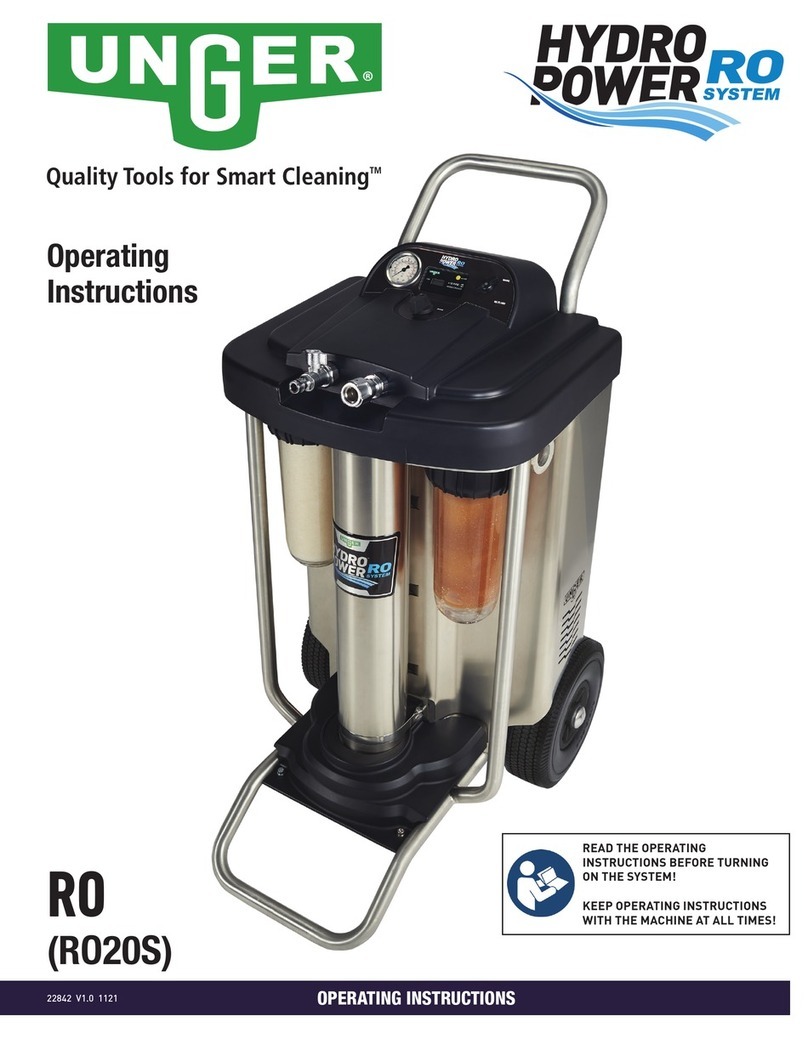
unGer
unGer HYDRO POWER RO20S operating instructions
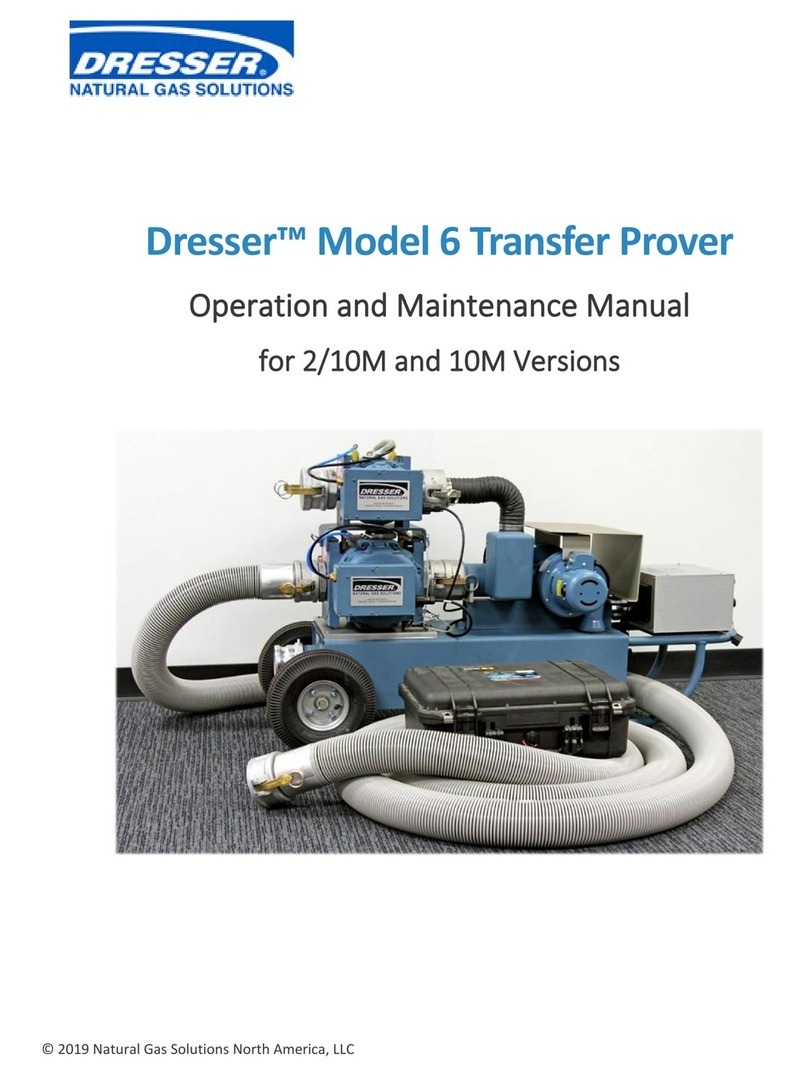
Dresser
Dresser Transfer Prover 6 Series Operation and maintenance manual
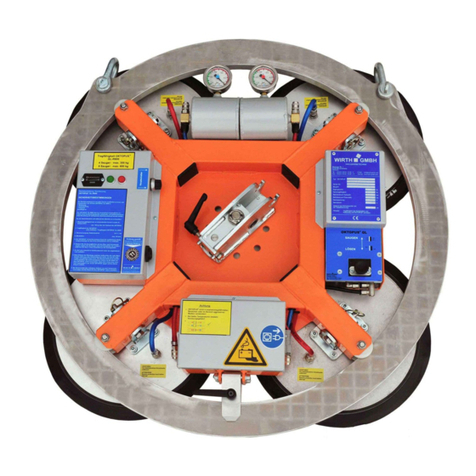
WIRTH
WIRTH OKTOPUS GL-R600 operating instructions

Matrix Cleaning Systems
Matrix Cleaning Systems SMO4 user manual

Belanger
Belanger H2AIR ARCH owner's manual
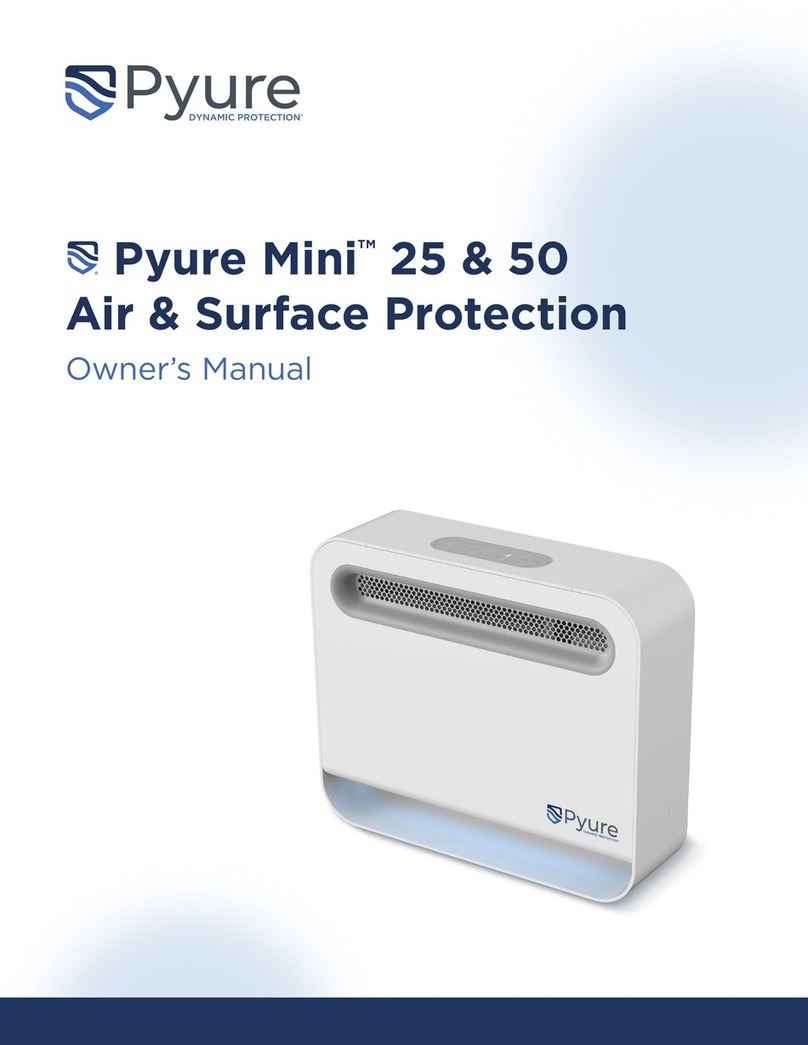
Pyure
Pyure Mini 25 owner's manual
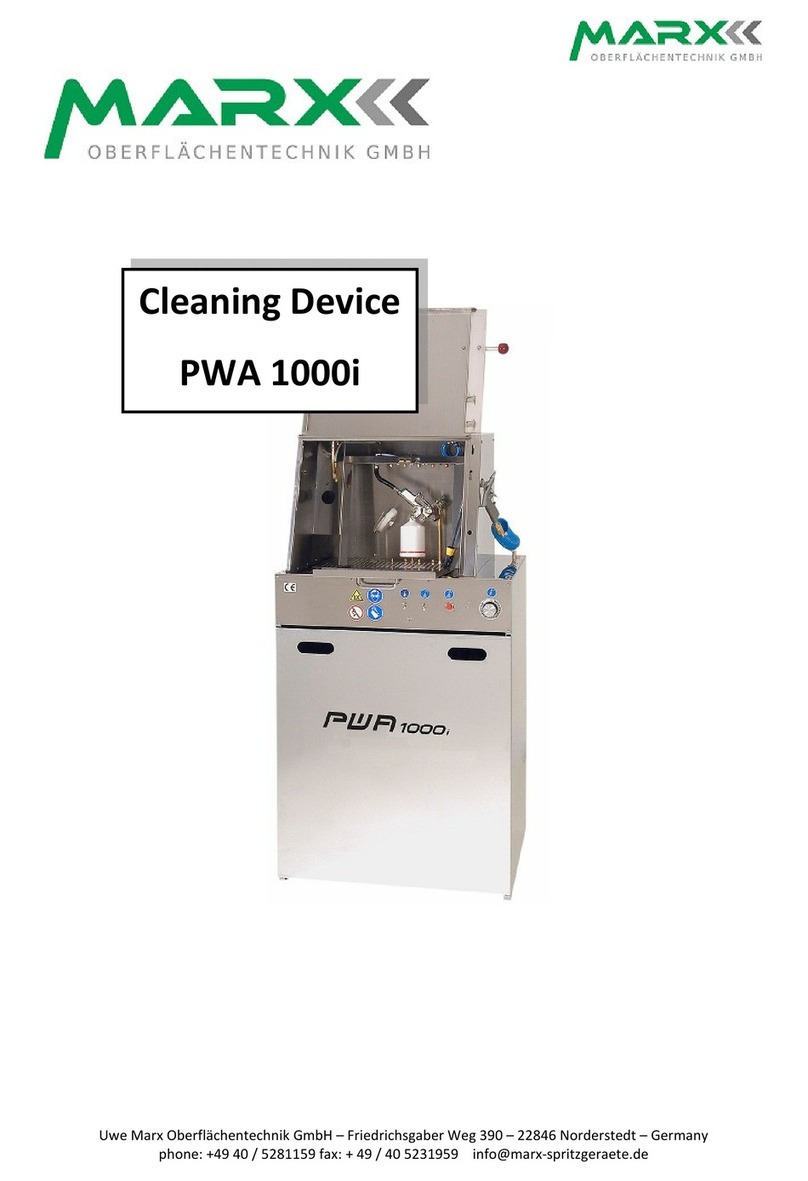
MARX
MARX PWA 1000i manual
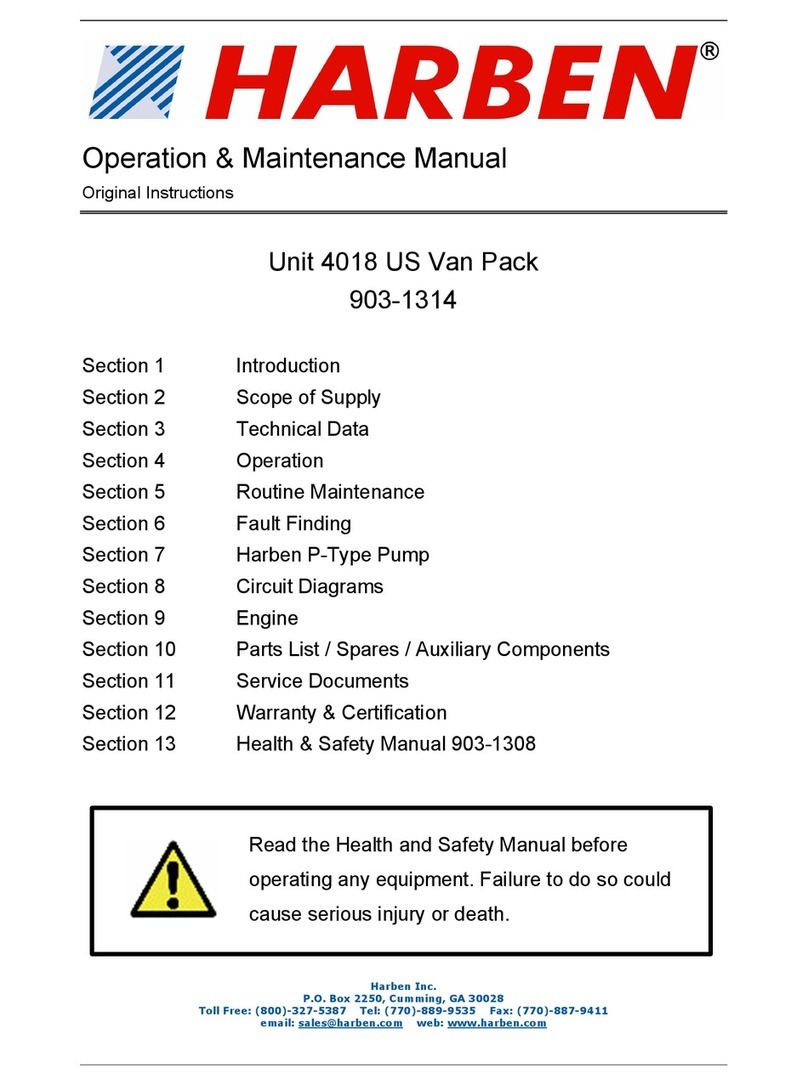
HARBEN
HARBEN 4018 US Van Pack Operation & maintenance manual

ESTELLE
ESTELLE DCS quick start guide

TEINNOVA
TEINNOVA Filnet B300 Ultrasonic user manual
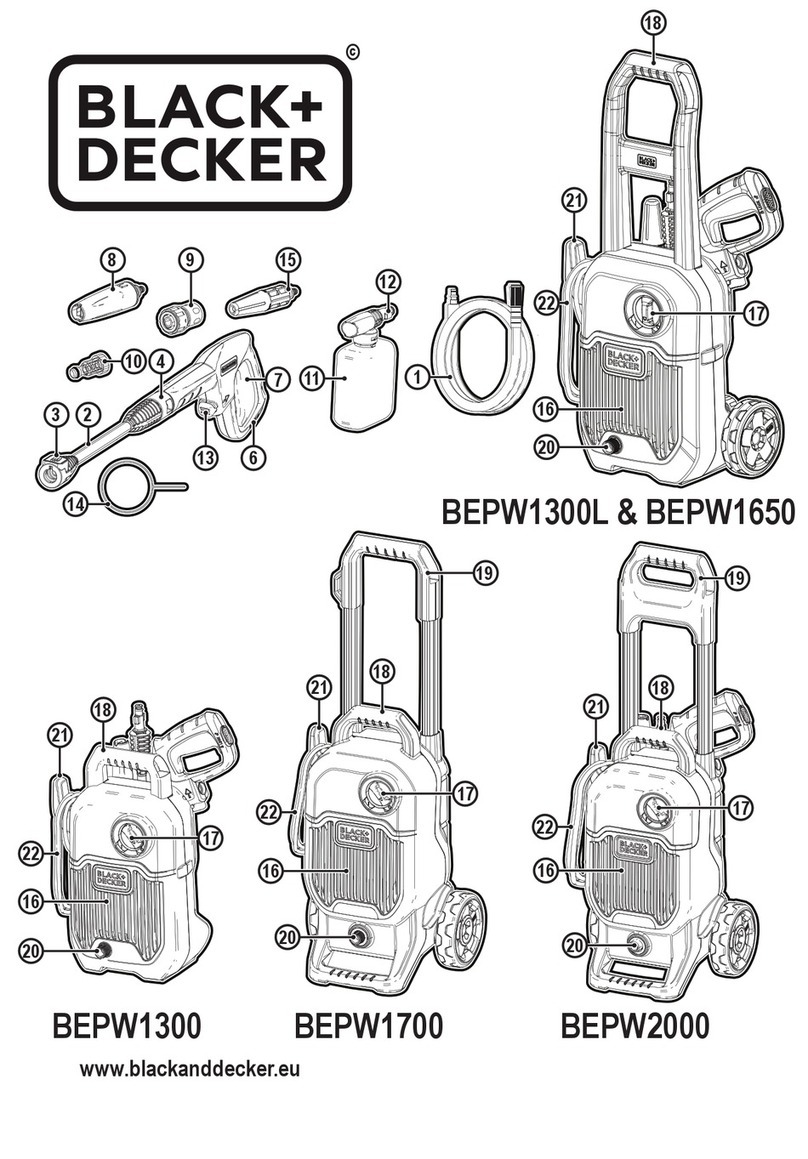
Black & Decker
Black & Decker BEPW1300L Original instructions
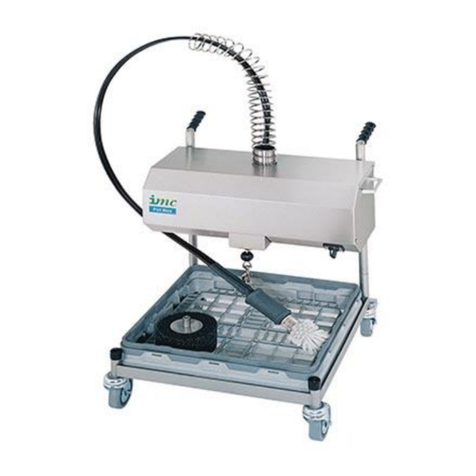
IMC
IMC POT BOY 6 Series Installation, operating and maintenance manual


